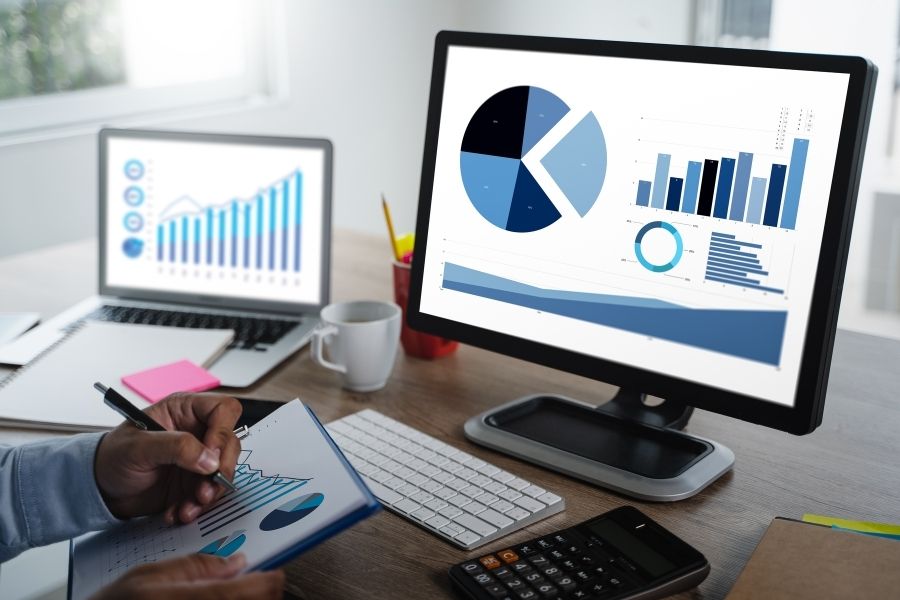Microsoft Power BI in finance
Power BI is an advanced analytical tool developed by Microsoft that enables users to transform raw data into interactive reports and visualisations. With its intuitive interface, Power BI allows accessible collection of data from a variety of sources, such as databases, Excel sheets, as well as ERP (Enterprise Resource Planning) and CRM (Customer Relationship Management) systems. The platform supports reporting processes and enables real-time data analysis, which is crucial for making fast and accurate business decisions. In today’s dynamic financial environment, Power BI is becoming an essential tool for organisations looking to increase their operational efficiency and improve the quality of financial reporting.
Use of Power BI in financial reporting
1. Integration with various data sources
Power BI enables integration with a variety of financial data sources to centralise information. By gathering data from ERP systems, CRM systems and Excel spreadsheets, users can create comprehensive financial reports that include all relevant data such as revenue, costs and profitability analysis. The effective integration of data from different sources is crucial as it provides a complete financial picture of the company, which is essential for making informed decisions.
2. Data modelling
Before starting to create reports, it is worth carefully planning the structure of the data model in Power BI. Establishing the right relationships between tables, such as accounting accounts, transactions and budgets, is crucial for subsequent analytics in financial reporting. Using modelling techniques, such as creating dimensions (e.g. expense categories) and measures (e.g. total revenue), allows for more precise analysis and better reporting of financial results.
3. Using advanced DAX functions
DAX (Data Analysis Expressions) is a formula language used in Microsoft Power BI for calculations and analysis. For financial reporting, familiarity with advanced DAX functions allows the creation of more complex calculations such as cost analyses, financial forecasts or project profitability assessments. This enables analysts to quickly deliver accurate reports that help with financial management and strategic decision-making.
4. Visualisations and dashboards
Power BI offers various visualisations that can be customised to suit an organisation’s needs. In financial reporting, selecting the right charts, tables, and maps is critical to presenting data effectively. Interactive dashboards enable users to monitor key economic indicators such as EBITDA, liquidity ratio or profit margin, making it easy to quickly identify trends and potential financial issues.
5. Automation and report scheduling
Microsoft Power BI also enables the automation of reporting processes by scheduling data refreshes and report generation. This enables users to receive up-to-date financial reports on a regular basis, keeping them up to date with the company’s financial performance and reacting quickly to changes. Automation also eliminates the risk of errors associated with manual data entry, which is particularly important in finance.
6. Security and accessibility
Data security is a key component of financial reporting. Power BI offers advanced data access management and permission controls to ensure that only authorised individuals can access sensitive financial information. Data protection is essential in financial reporting to prevent unauthorised access to information that can affect business decisions and a company’s reputation.
7. Training and support for users
Effective financial reporting optimization using Power BI requires appropriate user training. Providing access to training and technical support is key to effectively utilising the tool’s capabilities. In financial reporting, well-trained users can use Power BI’s features better, leading to more accurate analyses and reliable reports and, thus, better economic management for the company.
Optimising financial reporting with Power BI
Without a doubt, optimising financial reporting with Power BI is a process that requires planning, appropriate data modelling and knowledge of advanced data analytics capabilities. By improving data integration, applying advanced DAX functions and selecting the right visualisations, organisations can significantly increase the transparency and efficiency of financial reporting, ultimately resulting in better business decisions and greater control over finances. Microsoft Power BI, therefore, becomes a key tool in this process, enabling companies not only to collect and analyse data but also to make informed decisions based on sound financial information.


